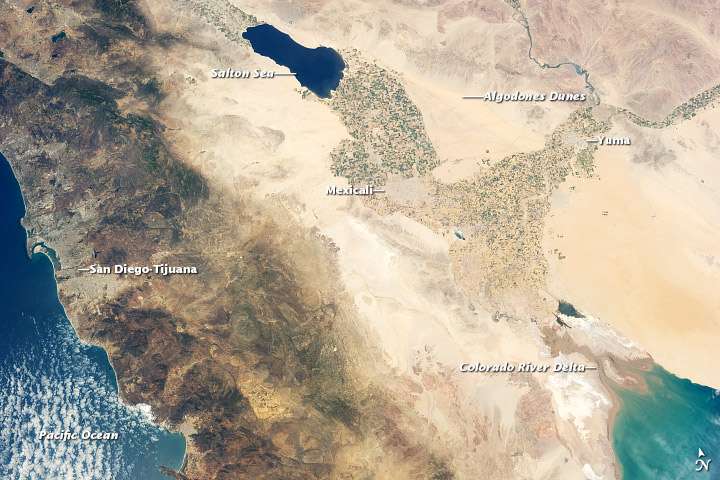Salton Sink
| Salton Sink | |
| physiographic section | |
 The Salton Sink is part of the Salton Watershed (light green area). | |
| Country | United States |
|---|---|
| State | California |
| Part of | Basin and Range Province |
| Parts | Coachella Valley, Imperial Valley |
| Coordinates | 33°20′00″N 115°50′03″W / 33.3334°N 115.8342°WCoordinates: 33°20′00″N 115°50′03″W / 33.3334°N 115.8342°W |
| Biome | Sonoran Desert ecoregion |
The Salton Sink is a geographic sink within the Salton Trough in the Coachella and Imperial valleys of southeastern California. It is in the Colorado Desert subregion of the Sonoran Desert ecoregion. Drainage to the endorheic sink collects in the Salton Sea, which occupies the lowest area of the sink.
Geology
The Salton Sink is the topographic low area within the Salton Trough, an active tectonic pull-apart basin.[1] The Salton Trough is a result of crustal stretching and sinking by the combined actions of the San Andreas Fault and the East Pacific Rise. The Brawley seismic zone forms the southeast end of the basin and connects the San Andreas Fault system with the Imperial Fault Zone to the south.[2] The Salton Buttes are rhyolite lava domes within the basin which were active 10,300 (± 1000) years BP.[3]
History
A large lake, Lake Cahuilla, existed in the area from about 20,500 to 3,000 years ago and left evidence as wave cut benches on the higher portions of the Salton Buttes.[3] A beach mark outlines the shoreline of ancient Lake Cahuilla where archeologists found rock fish traps and charred remains of razorback sucker and bonytail bones. High water lines suggest the basin has filled many times, creating a lake some 105 miles (170 km) in length and nearly 300 feet (100 m) deep. Its most recent incarnation is evidenced by fish traps found some 30 feet (10 m) below the high-water mark that were estimated to be between 300 and 1,000 years old. [4]
In recent times, the 1862 Colorado River flood waters reached the Salton Sink, filling it and creating a lake some 60 miles (95 km) long and 30 miles (50 km) wide.[5] In 1884 and 1891 the Colorado River had escapement flow into the Salton Sink.[6] The 1891 flood created a lake that covered an area 30 miles (50 km) long and 10 miles (15 km) wide.[7] A larger 1905 Colorado flood escaped into a diversion canal, forming the Alamo and New Rivers and creating the current Salton Sea in the sink's Coachella Valley.[8] A 1907 dam prevents flood escapements, but leakage still occurs to the Salton Sea.
View

References
| Wikimedia Commons has media related to Salton Sink. |
- ↑ Kearey, Philip and Frederick J. Vine, Global Tectonics, Blackwell Science, 2nd ed., 1996, pp. 131-133 ISBN 0-86542-924-3
- ↑ Fuis, Cary S. and Walter D. Mooney, Salton Trough Lithospheric Structure and Tectonics from Seismic-Refraction and Other Data in USGS Professional Paper 1515
- 1 2 "Salton Buttes". Global Volcanism Program. Smithsonian Institution.
- ↑ Wilke, P.J., Prehistoric weir fishing on recessional shorelines of Lake Cahuilla, Salton basin, southeastern California: Proceedings of the Desert Fishes Council, 1980, vol. 11, p. 101oe102.
- ↑ Wheeler, G.M., Annual report on the geographical surveys West of the one-hundredth meridian, in California, Nevada, Utah, Colorado, Wyoming, New Mexico, Arizona, and Montana: Appendix JJ, AnnualReport of the Chief of Engineers for 1876: Washington, D.C., Government Printing Office. 1876,
- ↑ History of the Salton Sea
- ↑ James, G.W., The wonders of the Colorado Desert: Volumes I and II. Little, Brown, and Company, Boston, 1906.
- ↑ A Sea in the Making in the Southland in The Salton Sea California's Overlooked Treasure
- ↑ Salton Trough July 29, 2013